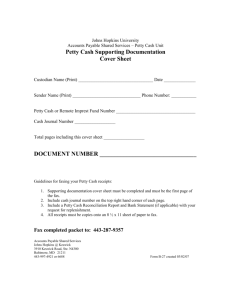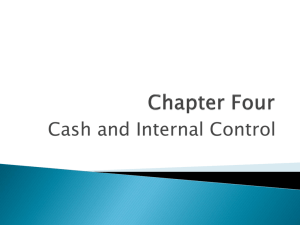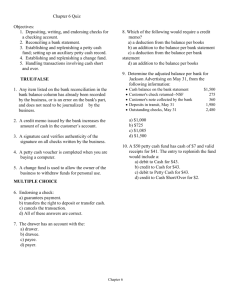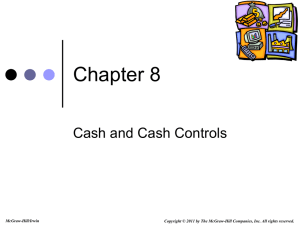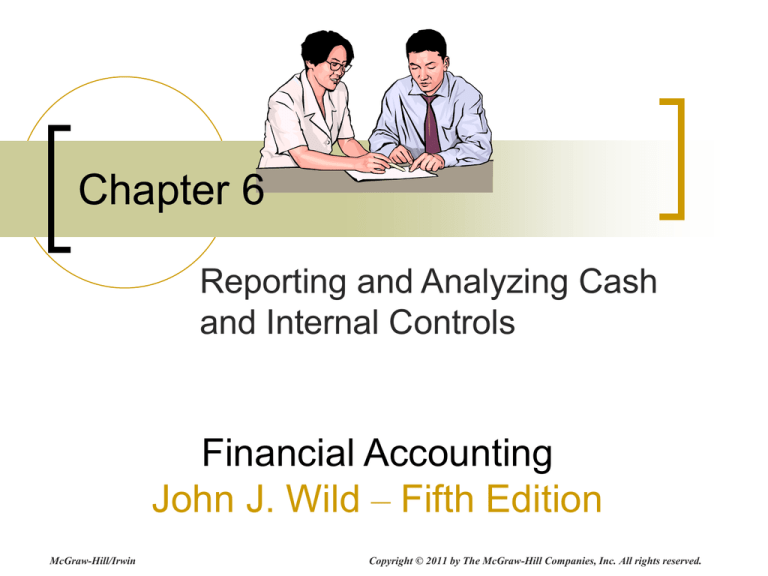
Chapter 6
Reporting and Analyzing Cash
and Internal Controls
Financial Accounting
John J. Wild – Fifth Edition
McGraw-Hill/Irwin
Copyright © 2011 by The McGraw-Hill Companies, Inc. All rights reserved.
C1
Purpose and Principles
of Internal Control
Principles of Internal Control
Purpose of Internal Control
Managers use policies and
procedures to:
1.
Protect assets.
2.
Ensure reliable accounting.
3.
Promote efficient
operations.
4.
Urge adherence to
company policies.
Establish responsibilities.
Maintain adequate records.
Insure assets and bond key
employees.
Separate recordkeeping from
custody
of assets.
Divide responsibility for related
transactions.
Apply technological controls.
Perform regular and
independent reviews.
6-2
C1
The Sarbanes-Oxley Act
The Sarbanes-Oxley Act, also known as SOX, requires
management and auditors of publicly held companies to
adhere to or perform specific requirements, such as:
1. Evaluation of internal controls.
2. Auditor’s work is overseen by the Public Company
Accounting Oversight Board (PCAOB).
3. Restriction on consulting services performed by
auditors.
4. Term limits on person leading the audit.
5. Harsh penalties for violators, including prison time
with severe fines.
6-3
C1
Technology and Internal Control
Reduced
Processing
Errors
More
Extensive Testing
of Records
Limited
Evidence of
Processing
Crucial
Separation of
Duties
Increased
E-commerce
6-4
C1
Limitations of Internal Control
Human Error
Human Fraud
Negligence
Fatigue
Misjudgment
Confusion
Intent to
defeat internal
controls for
personal gain
The costs of internal controls must not exceed their benefits.
6-5
C1
Control of Cash
An effective system of internal control that
protects cash and cash equivalents should meet
three basic guidelines:
Handling cash is
separate from
recordkeeping of
cash.
Cash receipts are
promptly deposited
in a bank.
Cash
disbursements are
made by check.
6-6
Control of Cash Receipts and
Cash Disbursements
P1
Over-the-Counter
Cash Receipts
Cash register with lockedin record of transactions.
Compare cash register
record with cash reported.
Cash Receipts By Mail
Two people open the mail.
Money to cashier’s office.
List to accounting dept.
Copy of list filed.
All expenditures should be made by check. The only
exception is for small payments from petty cash.
Separate authorization for check signing and
recordkeeping duties.
Use a voucher system.
6-7
P2
Operating a Petty Cash Fund
Petty Cash
Company
Cashier
Petty
Cashier
May 1
Petty cash
Cash
400
400
Accountant
6-8
P2
Operating a Petty Cash Fund
Petty Cash
Petty
Cashier
6-9
P2
Operating a Petty Cash Fund
A petty cash fund
is used only for
business
expenses.
Petty
Cashier
39¢
Stamps
$45
Courier
$80
6-10
P2
Operating a Petty Cash Fund
Petty cash
receipts with
either no
signature or a
forged signature
usually indicate
misuse of petty
cash.
Receipts
Petty
Cashier
39¢
Stamps
$45
Courier
$80
6-11
P2
Operating a Petty Cash Fund
Receipts
$125
Company
Cashier
To reimburse
petty cash fund
May 31
Use a Cash
Over and Short
account if needed.
Petty
Cashier
Postage expense
Delivery expense
Cash
45
80
125
Accountant
6-12
C3
Banking Activities as Controls
Bank Accounts
Checks
Signature Cards
Deposit Tickets
Electronic
Funds
Transfer
Bank
Statements
6-13
Bank Reconciliation
P3
A bank reconciliation is prepared periodically to explain the
difference between cash reported on the bank statement and the
cash balance on company’s books.
Bank Statement
First National Bank
Nashville, TN 37459
May 31, 2009
*
Clothes Mart
Nashville, TN
Why are the
balances different?
Acct No 278609
Previous
Balance
Total Checks
Total
Deposits
1488.79
5/1
5/2
5/4
5/7
1,367.09
107
2,604.22
55.00
108
109
279.50
44.75
5/9
5/12
5/15
5/18
110
111
21.81
37.55
112
175.98
5/21
5/27
5/30
5/31
113
114
288.31
12.54
115
451.65
Current
Balance
2,725.92
Account: Cash
GENERAL LEDGER
Acct. No.
1,251.88
Date
Item
May 31 Balance
PR
Debit
Credit
102
Balance
DR (CR)
2,481.18
825.04
527.30
6-14
P3
Reconciling Items
Bank Statement Balance
Add:
Deposits in transit.
Deduct:
Outstanding
Checks
Add or Deduct:
Bank errors.
•
•
•
•
•
Book Balance
Add: Collections
made by the bank.
Add: Interest earned
on checking account.
Deduct:
Nonsufficient funds
check (NSF).
Deduct: Bank
service charge.
Add or Deduct:
Book errors.
6-15
P3
Bank Reconciliation Example
Simmons Company
Bank Reconciliation
July 31, 2009
Bank Balance, July 31
Add: Deposit in Transit
Less: Bank Error
$ 486
Outstanding Checks
2,417
Adjusted Balance, July 31
Book Balance, July 31
Add: Interest
Less: Recording Error
NSF Check
Adjusted Balance, July 31
July 31 Cash
Interest revenue
$ 9,610
500
(2,903)
$ 7,207
$ 7,430
30
$
28
225
Dr.
30
(253)
$ 7,207
Only amounts shown on the
book portion of the reconciliation
require an adjusting entry.
July 31 Supplies expense
Accounts receivable
Cash
30
28
225
GENERAL LEDGER
Account: Cash
Acct. No.
Date
Item
July 31 Balance
31 Adjusting entry
31 Adjusting entry
Cr.
253
101
Balance
PR Debit Credit DR (CR)
7,430
30
7,460
253
7,207
6-16
A1
Days’ Sales Uncollected
How much time is likely to pass before
we receive cash receipts from credit sales?
Days’
=
sales
uncollected
Accounts receivable
Net sales
× 365
6-17
End of Chapter 6
6-18


